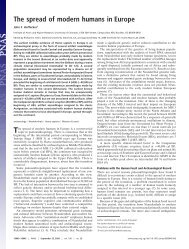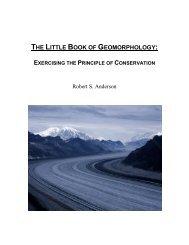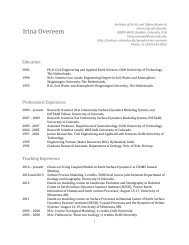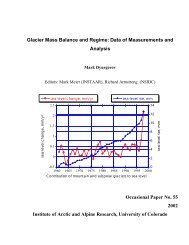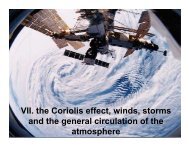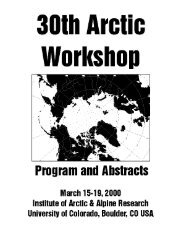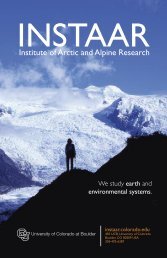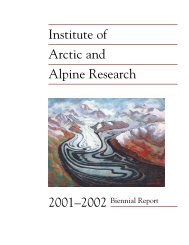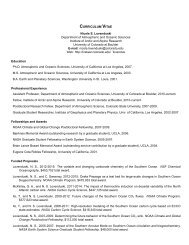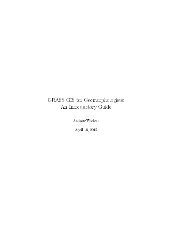Teacher resource kit supplies forthe field activity “MacroinvertebrateMania!,” from theteacher curriculum guide “MyH 2 O,” developed by ColleenFlanagan under the direction <strong>of</strong>Diane McKnight, Spring 2<strong>00</strong>6.The guide promotes awareness <strong>of</strong>the Boulder and St. Vrain watersheds,and copies were distributedto area public and privateschools in Spring 2<strong>00</strong>6. The projectwas funded by the NiwotRidge Long-Term EcologicalResearch Program. Photo:Colleen Flanagan (<strong>INSTAAR</strong>).<strong>INSTAAR</strong> SCIENTISTS DISCUSSPOLAR RESEARCH AT PUBLIC EVENTFOR UPCOMING INTERNATIONALPOLAR YEAR. John Behrendt, Jim White,Karen Cozzetto, and several other CUBoulder scientists shared their experiences inthe Arctic, Greenland, and Antarctic in a prelude to the nextInternational Polar Year, or IPY, in 2<strong>00</strong>7. Titled “Countdownto IPY,” the free, public event focused on past and currentresearch efforts at Earth’s polar regions by CU Boulder facultyand graduate students. The event also included a briefhistory <strong>of</strong> IPY, an international, interdisciplinary researchcampaign last held in 1957, which will involve the efforts <strong>of</strong>more than 60 nations beginning next year. IPY will <strong>of</strong>ficiallyrun from March 2<strong>00</strong>7 to March 2<strong>00</strong>9 to allow for two fullseasons <strong>of</strong> field work in the Arctic and Antarctic.Participating scientists will use high-tech tools ranging fromsatellites, autonomous vehicles, and remotely operated climatestations to GPS, laser altimeters, and supercomputersto better understand the roles the polar regions play in avariety <strong>of</strong> global processes. Researchers involved in IPY willaddress such issues as dwindling sea ice, shrinking icesheets and glaciers, thawing permafrost, and creatures rangingfrom polar bears and penguins to marine life andmicrobes.THE NINTH CIRCLE: A MEMOIR OF LIFEAND DEATH IN ANTARCTICA,1960–1962. John Behrendt published anmemoir <strong>of</strong> his work with the United StatesAntarctic Research Program in the early1960s, when the Cold War was at its heightand research on the ice sheet was risky. TheAntarctic air squadron VX6 had an accident rate eight timesthat <strong>of</strong> U.S. Naval aviation in other parts <strong>of</strong> the world, andgraduate students and young scientists like BehrendtResearchers take a breakand play Frisbee at thebase <strong>of</strong> Canada Glacier,Taylor Valley, Antarctica,January 2<strong>00</strong>6. Manyplayers are members <strong>of</strong>the 2<strong>00</strong>5–2<strong>00</strong>6 Antarctic“Stream Team,”which studied thehydrology and ecology<strong>of</strong> glacial meltwaterstreams and is supportedby NSF’s McMurdoDry Valleys Long-TermEcological Research(LTER) program. Photo:Karen Cozzetto(<strong>INSTAAR</strong>).received hazard pay for their work. In Behrendt’s memoir werelive that era <strong>of</strong> scientific explorations with him. Hedescribes two seasons on the ice in Operation Deep Freeze,leading field parties, conducting scientific research, andstruggling against the elements. Behrendt led an over-snowgeophysical-glaciological-geologic-geographic explorationparty to the southern Antarctic Peninsula and to a mountainrange that was eventually named for him in recognition<strong>of</strong> his work. Behrendt pioneered aerogeophysical surveysover the Transantarctic Mountains and the West AntarcticIce Sheet. In his reflections on the period from 1956 to1962, he notes the time was closer to the eras <strong>of</strong> ErnestSchackleton (Endurance voyage, 1914) and Robert F. Scottand Roald Amundsen’s treks to the South Pole(1911–1912) than to the present. Readers fascinated withthe 20th century frontier <strong>of</strong> our shrinking planet will relishhis adventurous account.OZONE AND THE OCEANS. ShellySommer created a poster display for theDis<strong>cover</strong>y Science Center that describes aproject, led by Detlev Helmig, to measureozone fluxes over the oceans. The displayalso explains the role <strong>of</strong> ozone in the tropospherevs. the stratosphere. The hands-on science center islocated in Fort Collins, Colorado, and serves 35,<strong>00</strong>0 visitorseach year; many attendees are children from northernColorado and Wyoming. A companion web site, “Ozoneand the Oceans,” was created with the assistance <strong>of</strong> DavidLubinski. The site is an educational resource for grades 5–12that describes the science, introduces team members, andprovides updates on the project, a glossary, and downloadablePDFs <strong>of</strong> the Science Center posters. The site has beenadded to the Digital Library for Earth Science Education(DLESE) and the National Science Digital Library (NSDL).38 | SOCIETAL MISSION
Spotlights: Honors, Awards,and RecognitionDAVID ANDERSON RECEIVEDARTHUR S. FLEMING AWARD. DavidAnderson received the 2<strong>00</strong>5 Arthur S.Fleming Award from George Washington<strong>University</strong> for excellence in scientificresearch, one <strong>of</strong> three recipients. Theaward recognizes excellence in the federalworkforce. Recognized by the President <strong>of</strong>the United States, agency heads, and the private sector, thewinners are selected from all areas <strong>of</strong> the federal service.Anderson and his colleagues at NOAA have developed apopular and <strong>of</strong>ten-used archive <strong>of</strong> paleoclimate records <strong>of</strong>past climate change, the World Data Center forPaleoclimatology. These observations extend the instrumentalrecord <strong>of</strong> weather observations back thousands <strong>of</strong> years,providing a longer record <strong>of</strong> climate variability. The paleorecords also provide insights into possible future climatechange. The Fleming medal ceremony was held inWashington, DC, on June 13, 2<strong>00</strong>6.JOHN BEHRENDT ELECTEDPRESIDENT OF THE AMERICANPOLAR SOCIETY. John C. Behrendt waselected President <strong>of</strong> the prestigiousAmerican Polar Society in spring 2<strong>00</strong>6.The society, founded in 1934, has a missionto foster interest in research andexploration in the Arctic, Antarctic, and polar-like regions.Behrendt made his first trip to Antarctica in 1956 as a graduatestudent, where he wintered over at Ellsworth Station,and has continued his work in Antarctica on 12 additionalexpeditions, the last in 2<strong>00</strong>3. He is one <strong>of</strong> two or three peoplein the world who have worked in the U.S. Program inAntarctica in parts <strong>of</strong> six successive decades. The BehrendtMountains in Ellsworth Land were named for him as a result<strong>of</strong> an over-snow traverse that he led using Sno-Cats in thatarea in 1957–1958.Behrendt was employed by the U.S. Geological Surveyfor 31 years, has also been a member <strong>of</strong> the U.S. StateDepartment delegation to 22 Antarctic Treaty ConsultativeMeetings, and has authored two books about his Antarcticexperience, in 1998 and 2<strong>00</strong>5, respectively—Innocents onthe Ice; a Memoir <strong>of</strong> Antarctic Exploration, 1957 and TheNinth Circle; a Memoir <strong>of</strong> Life and Death in Antarctica,1960–1962. His current research at <strong>INSTAAR</strong> includes thestudy <strong>of</strong> geophysical evidence for subglacial late Cenozoicvolcanism beneath the Antarctic ice sheet.In addition to Antarctica, Behrendt carried out geophysicalinvestigations in West Africa, the Atlantic continentalmargin <strong>of</strong> the U.S., and the Rocky Mountains. Hemakes his home in Boulder and always has a backpackready for another expedition to the world’s most remotecontinent.BOB ANDERSON ELECTED AFELLOW OF THE AMERICANGEOPHYSICAL UNION. Robert S.Anderson was elected a Fellow <strong>of</strong> theAmerican Geophysical Union for “fundamentaland pioneering contributions inquantitative geomorphology, geochronology,hydrology and glaciology.” Fellowship is bestowed ononly 0.1% <strong>of</strong> the total AGU membership <strong>of</strong> about 35,<strong>00</strong>0in any given year and recognizes scientistswho have attained acknowledged eminencein the geophysical sciences.Anderson has been a leader in the distinctivecombination <strong>of</strong> rigorous field measurementsand numerical modeling. Hisapproach involves monitoring modern systems,numerical modeling <strong>of</strong> these systemsconstrained by modern rates, and establishment<strong>of</strong> a chronology that constrains thelonger-term pace <strong>of</strong> landscape evolution. Hehas successfully applied this approach toclassic problems <strong>of</strong> geomorphology such aseolian transport, rock abrasion, and the evolution<strong>of</strong> glacial valleys and whole landscapes.Anderson’s keen desire to understandthe processes that drive landscapeevolution has led him to work (1) at scalesfrom sand-grain trajectories to mountainranges, (2) in environments from deserts tothe Arctic, and (3) with techniques fromfluid mechanical simulation to cosmogenicradionuclide dating.Throughout his distinctive and variedscientific contributions, Anderson hasshared his work and publication historywith a long list <strong>of</strong> students and colleagues.Though the work has obviously benefitedfrom their talent and energy, Anderson’senduring and distinctive contribution is clearly visible. Hiscollaborative and generous approach continues with his roleas the founding editor <strong>of</strong> the new AGU journal JGR–EarthSurface.JOHN ANDREWS ELECTED AFELLOW OF THE AMERICANGEOPHYSICAL UNION. John T.Andrews was elected a Fellow <strong>of</strong> theAmerican Geophysical Union(Paleoceanography and PaleoclimatologyFocus Group) “for his seminal contributionsto the Quaternary history <strong>of</strong> North America and theNorth Atlantic Basin.” Fellowship is bestowed on only 0.1%<strong>of</strong> the total AGU membership <strong>of</strong> about 35,<strong>00</strong>0 in any givenBob Anderson and John Andrews(both <strong>INSTAAR</strong>) on their way tothe American Geophysical Union(AGU) Fellowship honor’s ceremony,San Francisco, California,Spring 2<strong>00</strong>6. Both Anderson andAndrews were elected AGUFellows. Fellowship is bestowedon only 0.1% <strong>of</strong> the total AGUmembership <strong>of</strong> about 35,<strong>00</strong>0 inany given year and recognizesscientists who have attainedacknowledged eminence in thegeophysical sciences. Photo:Suzanne Anderson (<strong>INSTAAR</strong>).PEOPLE | 39
- Page 1 and 2: INSTAARInstitute of Arctic and Alpi
- Page 3 and 4: BiennialReport2005-2006Institute of
- Page 5 and 6: INSTAAR: An Earth andEnvironmental
- Page 7 and 8: CU-Denver campus where she helped t
- Page 9 and 10: Where in the world is INSTAAR? Acti
- Page 11 and 12: The instrument was deployed on NOAA
- Page 13 and 14: altered by humans over the past 200
- Page 15 and 16: ties. However, manmade reservoirs a
- Page 17 and 18: Arctic WorkshopThe annual Arctic Wo
- Page 19 and 20: Wendy Roth (INSTAAR) explains the p
- Page 21 and 22: camera equipment. These laboratorie
- Page 23 and 24: Research Grants: Fiscal Years2004-2
- Page 25 and 26: Ogilvie, Astrid: NSF. HSD: Human an
- Page 27 and 28: Theses Completed2005Breiter, Nehale
- Page 29 and 30: Gifford MillerGEOL 1060, Global Cha
- Page 31 and 32: Lana Cohen, MS, Atmospheric and Oce
- Page 33 and 34: Trevor Popp, PhD, Geological Scienc
- Page 35 and 36: Societal Outreach andInformal Educa
- Page 37 and 38: A group of students from Southern H
- Page 39: Outreach SpotlightsUNDERGRADUATE ME
- Page 43 and 44: TIM SEASTEDT WINS THE 2005PACESETTE
- Page 45 and 46: Structure of hierarchically organiz
- Page 47 and 48: William F. ManleyFellow of INSTAAR.
- Page 49 and 50: Alan R. TownsendFellow and Associat
- Page 51 and 52: GeophysicsEdmund AndrewsChief River
- Page 53 and 54: INSTAAR Visiting Scientists,2005-20
- Page 55 and 56: Chris JarosSupervisor: Diane McKnig
- Page 57 and 58: INSTAAR Noon SeminarsSpring 2005Tad
- Page 59 and 60: Graduate Student TalksSpring 2005Ry
- Page 61 and 62: Journal and BooksArctic, Antarctic,
- Page 63 and 64: Publications2005Adams, P. N., Storl
- Page 65 and 66: “El Nino suppresses Antarctic war
- Page 67 and 68: European settlement of Lake Eyre, S
- Page 69 and 70: tion of Baffin Island, Arctic Canad
- Page 71 and 72: and soil quality for sustainable gr
- Page 73 and 74: Andrews, J. T., Eberl, D. D., and K
- Page 75 and 76: Cleveland C. C., Reed S. C., and To
- Page 77 and 78: and Pierre Y. Julien. Journal of Hy
- Page 79 and 80: Tributaries to the ColoradoRiver th
- Page 81 and 82: Rocchi, S., LeMasurier, W. E., and



